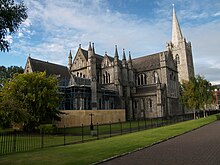Talk:St Patrick's Cathedral, Dublin
| This article is rated B-class on Wikipedia's content assessment scale. It is of interest to the following WikiProjects: | |||||||||||||||||||||||||||||||
| |||||||||||||||||||||||||||||||
New photo of the building
[edit]
Souvenir from a trip to Dublin. Could use a bit of work, but the higher resolution and better lighting might justify the effort. Regards, Paradoctor (talk) 01:10, 1 November 2009 (UTC)
Forced alienation?
[edit]Looking at - "The forced alienation of sacred places from one community to another leaves lasting scars" - how does that relate to this building?86.42.209.185 (talk) 16:18, 12 September 2012 (UTC)
- It relates because the building was once the property of the Catholic Church. Following the Reformation, agents of the State, acting on behalf of the Established Church, appropriated it for the exclusive use of the Church of Ireland. Roman Catholic adherents, who were the majority of the population, were thereby dispossessed of the building and its revenues. They were obliged to conduct their services elsewhere in secret until the relaxatin of the Penal Laws. This process left some lasting scars in the dispossessed community, a fact which the Church of Ireland, until recent times, was unable to acknowledge. The sentance provides good balance and shows how the healing process has begun. Laurel Lodged (talk) 20:07, 12 September 2012 (UTC)
- I have removed the quote from the article.
- It was misleadingly attributed to "some Anglicans", whereas it was actually a quote from a letter to the editor of the Irish Times from one individual Anglican priest writing from France. No independent sources were provided to attest to the significance of this view, nor of the significance of any underlying controversy.
- If there is wider coverage of a controversy around the ownership of the Ctahedral, then the quote may have a place in that, but even in that situation there are WP:WEIGHT issues. --BrownHairedGirl (talk) • (contribs) 08:02, 17 September 2012 (UTC)
It still has: "During the confiscation process.." but it was never confiscated. Archbishop John Alen was murdered in 1534 by the rebel Thomas FitzGerald, 10th Earl of Kildare because Alen was a supporter of Cardinal Wolsey. His replacement in 1536 was George Browne (archbishop of Dublin). Henry VIII was excommunicated by the Papacy in 1538.78.19.203.175 (talk) 11:51, 6 October 2016 (UTC)
Assessment comment
[edit]The comment(s) below were originally left at Talk:St Patrick's Cathedral, Dublin/Comments, and are posted here for posterity. Following several discussions in past years, these subpages are now deprecated. The comments may be irrelevant or outdated; if so, please feel free to remove this section.
| 1. Who cut the hole? The two following reports differ. It is plausible that the people on the outside did it. One thing is sure: One of the two articles is wrong.
2. Who was inside, who was outside the door? The second report is ambiguous on which side of the door each of the two combattants were. The medieval Chapter House door (1492) has a hole in it, made during the feud between the Butlers of Ormonde and the Fitzgeralds of Kildare: the Earl of Kildare sought refuge here, and the Earl of Ormonde cut the hole in the door, to shake hands and make peace with him; this gave rise to the phrase 'chancing your arm'. http://www.softguides.com/dublin/culture/stpats.html Wikipedia article: Legend has it that Saint Patrick's was the origin of the expression "[1]chancing your arm" (meaning to take a risk), when Gerald, Earl of Kildare cut a hole in a door there, still to be seen, and thrust his arm through it, in an effort to call a truce with another Earl, James of Ormond, in 1492. |
Last edited at 01:54, 1 January 2012 (UTC). Substituted at 06:48, 30 April 2016 (UTC)
Used by whom in 1688-90?
[edit]The article has the following:
- "In 1688–90, during the Williamite War in Ireland, James II and his fellow Catholics briefly repossessed St Patrick's. James attended Mass services there with his Jacobite supporters for a time."
King James II was Catholic, but remained at the same time the head of the Anglican churches of England and Ireland. During the "Patriot Parliament" of 1689 he invited the Irish Anglican bishops to sit. It would be interesting for these sentences to be sourced properly, and altered if needed, whatever was the case.78.16.115.42 (talk) 12:04, 11 July 2017 (UTC)
I haven't come across Mass being said in St. Patrick's, but there are several mentions of Mass being said in Christchurch Cathedral during the Patriot Parliament. The Anglicans hid the plate, candle-sticks, etc., under a coffin to prevent the priests from celebrating Mass, but a priest found some old iron candle-sticks and made do with some old furniture so that Mass could be celebrated. In fact I think those same candle-sticks are still there in Christchuch. Hohenloh + 18:13, 11 July 2017 (UTC)
Renovations since the 19th century
[edit]There is probably a need for a small addition to the history covering major works since the great restoration / rebuilding. One of these projects, focused on the roof, is ongoing in 2020. SeoR (talk) 11:45, 15 July 2020 (UTC)



